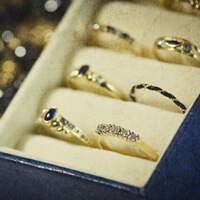7 Characteristics of Georgian Jewellery
 Spanning the reigns of the King Georges I, II, III, and IV, the Georgian period (1714-1837) was a time of change within England, when printed literature became more widely available, the arts flourished, and fashion became lighter and more delicate.
Spanning the reigns of the King Georges I, II, III, and IV, the Georgian period (1714-1837) was a time of change within England, when printed literature became more widely available, the arts flourished, and fashion became lighter and more delicate.
The romance of Georgian style also extended to jewellery; great care and attention was given to creating eye-catching jewellery that was expertly crafted and impeccably finished. The Georgian Period saw an increased interest in architecture, and this is certainly reflected in the jewellery of this era.
1. Handmade
The goldsmiths of the Georgian era were highly qualified technicians, and always used gold alloys of 18 carat and higher. From start to finish, each piece of jewellery was completely handcrafted.
2. Repoussé
Repoussé is a metalworking technique used to create a raised design by hammering a piece of metal on the reverse side. This gives the intricate shape and detail that is prevalent on many Georgian designs.
3. Beauty from all angles
A well-made piece of Georgian Jewellery has been carefully designed, with every inch of the piece thought about from an aesthetic point of view. The gold on the underside of a ring with often feature etching and repoussé, and the edging of a brooch might include rows of pearls, diamonds or gold filigree.
4. Naturalistic Designs
Nature was a significant inspiration for Georgian style, influencing poetry, clothing, and jewellery of course. Insects, birds, flowers and feathers are among the naturalistic designs featured within jewellery styles.
5. Lover’s Eye Miniatures
During the late 1700s, a young George IV fell in love with a commoner while his father was losing the American Revolutionary War. George IV’s lover gave him a locket concealing a miniature painting of her eye, so that she could keep eye contact with the prince while preserving her anonymity. For about 30 years after this, ‘Lover’s Eye’ Miniatures were all the rage in England.
6. A demand for diamonds
As diamonds were becoming increasingly popular at the start of the 18th Century, the demand grew and many colourless alternatives, such as rock crystal and marcasite, were used to keep jewellery accessible for everyone. Real diamonds were also beginning to be cut in new ways – the ‘rose’ and ‘brilliant’ cut were first introduced in this era.
7. Dearest & Regard Rings
These rings started to be seen in the early 1800s, and were given to send a special message to the recipient from an admirer. A “Dearest” ring might contain a diamond, emerald, amethyst, ruby, emerald, sapphire and topaz, with the first letter of each stone spelling out the word.
For a closer look at antique jewellery from the Georgian period, you are welcome to visit one of our shops where we would be more than happy to show you our latest pieces in stock.




